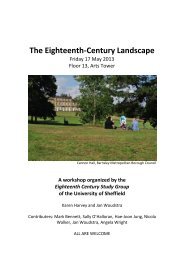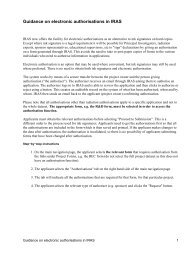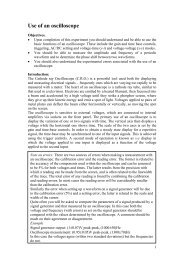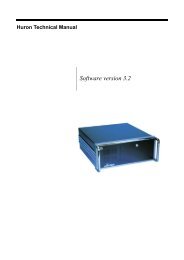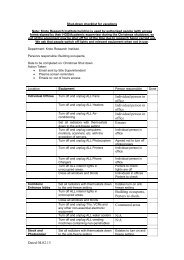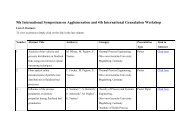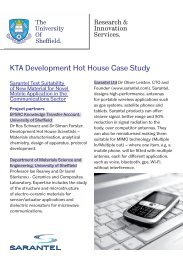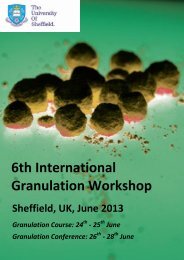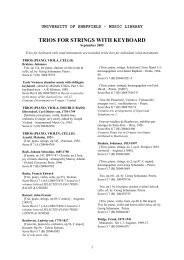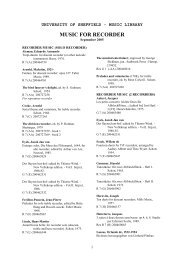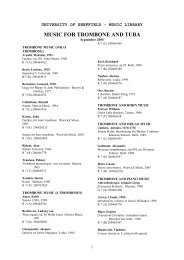Acceptability and effectiveness of a strategy for the communication ...
Acceptability and effectiveness of a strategy for the communication ...
Acceptability and effectiveness of a strategy for the communication ...
Create successful ePaper yourself
Turn your PDF publications into a flip-book with our unique Google optimized e-Paper software.
<strong>Acceptability</strong> <strong>and</strong> <strong>effectiveness</strong> <strong>of</strong> a <strong>strategy</strong> <strong>for</strong> <strong>the</strong><br />
<strong>communication</strong> <strong>of</strong> <strong>the</strong> diagnosis <strong>of</strong> non-epileptic attacks<br />
Authors: Lindsey Hall-Patch 1 , Richard Brown 2 , Allan House 1 , Stephanie<br />
Howlett 3 , Steven Kemp 4 , Gemma Lawton 3 , Rebecca Mayor 3 , Phil<br />
Smith 5 <strong>and</strong> Markus Reuber 3* <strong>for</strong> <strong>the</strong> NEST collaborators 6<br />
Correspondence: *: Markus Reuber, Academic Neurology Unit, University <strong>of</strong> Sheffield,<br />
Affiliations:<br />
Royal Hallamshire Hospital, Glossop Road, Sheffield, S10 2JF. UK.<br />
E-mail: markus.reuber@sth.nhs.uk, Tel.: +44 114 2268688, Fax: +44<br />
114 2713158.<br />
1 : Academic Unit <strong>of</strong> Psychiatry <strong>and</strong> Behavioural Sciences, University<br />
<strong>of</strong> Leeds, Leeds LS2 9LJ, UK. L.A.Hall-Patch@leeds.ac.uk<br />
2 : Division <strong>of</strong> Clinical Psychology, University <strong>of</strong> Manchester,<br />
Manchester, M13 9PL, UK. richard.james.brown@manchester.ac.uk<br />
3 : Academic Neurology Unit, University <strong>of</strong> Sheffield, Royal<br />
Hallamshire Hospital, Sheffield, S10 2JF, UK.<br />
stephanie.howlett@sth.nhs.uk<br />
4 : Department <strong>of</strong> Neuropsychology, Leeds Teaching Hospitals NHS<br />
Trust, St James’s Hospital, Leeds, LS9 7TF, UK.<br />
a.o.house@leeds.ac.uk<br />
5 : Department <strong>of</strong> Neurology, University Hospital <strong>of</strong> Wales, Cardiff,<br />
CF14 4XW. SmithPE@cardiff.ac.uk<br />
6 : The o<strong>the</strong>r Non-Epileptic Seizure Treatment (NEST) collaborators<br />
are: Dr Naghme Adab, Coventry; Dr Jane Adcock, Ox<strong>for</strong>d; Dr Steven<br />
Allder, Plymouth; Dr Holger Allroggen, Coventry; Dr Jonathan Bird,<br />
Bristol; Dr Peter Clough; Dr Hannah Cock, London; Dr Paul Cooper,<br />
Manchester; Dr Gary Dennis, Sheffield; Dr Peter Goulding, Leeds; Dr<br />
Richard Grünewald, Sheffield; Dr Yvonne Hart, Ox<strong>for</strong>d; Dr Steven<br />
Howell, Sheffield; Dr Mark Man<strong>for</strong>d, Bed<strong>for</strong>d; Dr. Tony Marson,<br />
Liverpool; Dr Piers Newman, Here<strong>for</strong>d; Dr Andrew Nicholson,<br />
Liverpool; Dr Fiona Pattison, Bristol; Dr Martin Sadler, Plymouth; Dr<br />
David Smith, Liverpool; Dr Tim von Oertzen, London; Dr Martin<br />
Zeidler, Kirkcaldy<br />
Running title: A <strong>communication</strong> protocol <strong>for</strong> NEA<br />
Key words: Psychogenic non-epileptic seizures, diagnosis, <strong>communication</strong>,<br />
illness perceptions, psychological treatment<br />
Statistics: Manuscript including abstract: 26 pages, 4 tables, 1 box, 1 figure<br />
1
Summary<br />
Purpose: Communicating <strong>the</strong> diagnosis <strong>of</strong> psychogenic non-epileptic<br />
seizures (PNES) is a challenging task. This study was carried out to assess<br />
<strong>the</strong> acceptability <strong>and</strong> <strong>effectiveness</strong> <strong>of</strong> a new <strong>communication</strong> procedure<br />
consisting <strong>of</strong> a patient in<strong>for</strong>mation leaflet <strong>and</strong> a <strong>communication</strong> <strong>strategy</strong> <strong>for</strong><br />
neurologists.<br />
Methods: In a multicentre prospective study, 50 patients newly diagnosed<br />
with PNES were in<strong>for</strong>med about <strong>the</strong> diagnosis by ten different neurologists<br />
using <strong>the</strong> <strong>communication</strong> procedure. Follow-up data were ga<strong>the</strong>red by<br />
telephone interview <strong>and</strong> completion <strong>of</strong> a questionnaire about symptom<br />
attributions (psychological/physical) <strong>and</strong> illness cognitions (Illness Perception<br />
Questionnaire-Revised, IPQ-R).<br />
Results: 94% <strong>of</strong> patients found <strong>the</strong> leaflet easy to underst<strong>and</strong>. 94% stated<br />
<strong>the</strong>ir questions were answered by <strong>the</strong> doctor, 70% got what <strong>the</strong>y wanted from<br />
<strong>the</strong> consultation, 94% stated <strong>the</strong>ir questions were answered by <strong>the</strong> doctor,<br />
only 4% reported feeling angry during <strong>the</strong> consultation. 86% <strong>of</strong> patients<br />
acknowledged that psychological factors were at least contributing to <strong>the</strong>ir<br />
seizures. On <strong>the</strong> IPQ-R, ‘emotional’ causes were endorsed more commonly<br />
than ‘non-emotional’ causes (p50% reduction in seizure frequency.<br />
Conclusion: We conclude that our procedure is acceptable <strong>and</strong> effectively<br />
communicates a psychological etiological model <strong>for</strong> PNES.<br />
2
Keywords: Psychogenic non-epileptic seizures, diagnosis,<br />
<strong>communication</strong>, illness perceptions, <strong>communication</strong>,<br />
psychological treatment<br />
3
<strong>Acceptability</strong> <strong>and</strong> <strong>effectiveness</strong> <strong>of</strong> a <strong>strategy</strong> <strong>for</strong><br />
<strong>the</strong> <strong>communication</strong> <strong>of</strong> <strong>the</strong> diagnosis <strong>of</strong><br />
Psychogenic non-epileptic seizures<br />
Introduction<br />
Psychogenic non-epileptic seizures (PNES) are episodes <strong>of</strong> altered<br />
movement, sensation or experience resembling epileptic seizures but not<br />
associated with epileptic discharges in <strong>the</strong> brain. They can be defined<br />
positively as episodes <strong>of</strong> loss <strong>of</strong> control which occur in response to distressing<br />
situations, sensations, emotions, conflicts or memories when alternative<br />
coping mechanisms are inadequate or have been overwhelmed (Reuber M.,<br />
2008). PNES are classified as a manifestation <strong>of</strong> dissociative or conversion<br />
disorder in <strong>the</strong> current nosologies (American Psychiatric Association, 1994;<br />
World Health Organization, 1992). Whilst many questions about <strong>the</strong>ir etiology<br />
remain unanswered, <strong>and</strong> <strong>the</strong>re are presently no proven interventions <strong>for</strong><br />
PNES, most neurologists consider psychological treatment <strong>the</strong> management<br />
<strong>of</strong> choice (LaFrance, Jr., Rusch & Machan, 2008).<br />
PNES are not uncommon. The population prevalence <strong>of</strong> PNES has been<br />
estimated as 2-33 per 100,000 (Benbadis, Allen & Hauser W.A., 2000). Two<br />
recent studies have shown that PNES make up 12 to 18% <strong>of</strong> patients<br />
newly presenting with seizures (Angus-Leppan, 2008; Kotsopoulos et al.,<br />
2003). The same studies suggest that, in a first seizure clinic, physicians<br />
should expect to make one diagnosis <strong>of</strong> PNES <strong>for</strong> every three or four <strong>of</strong><br />
epilepsy. However, most patients with PNES are initially misdiagnosed as<br />
4
having epilepsy. In fact, <strong>the</strong> diagnosis <strong>of</strong> PNES is typically only made after<br />
patients have been treated inappropriately with antiepileptic drugs <strong>for</strong> several<br />
years (Reuber et al., 2002; de Timary, Fouchet et al., 2002).<br />
Once <strong>the</strong> diagnosis has been made, neurologists face <strong>the</strong> challenge <strong>of</strong><br />
explaining to patients that <strong>the</strong>y do not have epilepsy, but that <strong>the</strong>ir seizures<br />
are a manifestation <strong>of</strong> psychological distress. This can be difficult as patients<br />
may be reluctant to accept that <strong>the</strong>ir seizures do not have a “physical” cause.<br />
Although <strong>the</strong>y report more symptoms <strong>of</strong> psychopathology <strong>and</strong> more negative<br />
life events (Lawton, Baker & Brown, 2008; Binzer, Stone & Sharpe, 2004;<br />
Galimberti et al., 2003; Reuber et al., 2003; Prueter, Schulz-Venrath &<br />
Rimpau, 2002) , as a group, patients with PNES are paradoxically less likely<br />
to agree that stress or emotional factors could be a cause <strong>of</strong> seizures than<br />
patients with epilepsy (Stone, Binzer & Sharpe, 2004).<br />
The question <strong>of</strong> how <strong>the</strong> diagnosis should be communicated has attracted<br />
considerable interest (Kanner, 2003; Harden & Ferr<strong>and</strong>o, 2001). One reason<br />
why “good” <strong>communication</strong> is important at this point is that outcome is better<br />
in patients who accept <strong>the</strong> diagnosis (Ettinger et al., 1999). In fact, PNES can<br />
resolve when clinicians have explained <strong>the</strong> nature <strong>of</strong> <strong>the</strong> problem (Kanner et<br />
al., 1999; Aboukasm et al., 1998). What is more, effective <strong>communication</strong> at<br />
this point has <strong>the</strong> potential to change patients’ healthcare utilization behavior<br />
significantly <strong>and</strong> reduce healthcare costs (Martin et al., 1998).<br />
5
At present, however, many patients report feeling confused or angry after<br />
receiving <strong>the</strong> diagnosis <strong>of</strong> PNES (Thompson, 2009; Thompson, Osorio &<br />
Hunter, 2005; Green, Payne & Barnitt, 2004; Carton, Thompson & Duncan,<br />
2003). Only three in five patients referred by a neurologist attend <strong>for</strong> an<br />
assessment interview <strong>for</strong> psychological treatment (Howlett et al., 2007).<br />
“Unsuccessful” <strong>communication</strong> may also increase <strong>the</strong> risk <strong>of</strong> continuing<br />
inappropriate treatment with anticonvulsants. We have previously shown that<br />
41% <strong>of</strong> patients diagnosed with PNES (<strong>and</strong> no additional epileptic seizures)<br />
were taking antiepileptic drugs a mean <strong>of</strong> four years after <strong>the</strong> diagnosis <strong>of</strong><br />
PNES (Reuber et al., 2003).<br />
A protocol <strong>for</strong> a more satisfactory <strong>communication</strong> <strong>of</strong> <strong>the</strong> diagnosis <strong>of</strong> PNES<br />
has been proposed (Shen, Bowman & Mark<strong>and</strong>, 1990), but its <strong>effectiveness</strong><br />
or acceptability has never been tested. A number <strong>of</strong> individuals <strong>and</strong><br />
organizations have produced in<strong>for</strong>mation leaflets <strong>for</strong> patients intended to help<br />
explain <strong>the</strong> diagnosis, but <strong>the</strong>se have not been evaluated in clinical studies<br />
ei<strong>the</strong>r (<strong>for</strong> examples see http://hsc.usf.edu/COM/epilepsy/PNESbrochure.pdf<br />
or<br />
http://www.epilepsyfoundation.org/about/types/types/nonepileptic/index.cfm).<br />
The primary aim <strong>of</strong> <strong>the</strong> present study was to evaluate <strong>the</strong> acceptability <strong>and</strong><br />
short-term <strong>effectiveness</strong> <strong>of</strong> a <strong>communication</strong> <strong>strategy</strong> consisting <strong>of</strong> a detailed<br />
patient in<strong>for</strong>mation leaflet <strong>and</strong> doctors’ guide encouraging clinicians to<br />
emphasize <strong>the</strong> core points made in <strong>the</strong> leaflet. The <strong>communication</strong> <strong>strategy</strong><br />
was designed to address all domains <strong>of</strong> patients’ illness representations.<br />
6
Illness representations are an essential part <strong>of</strong> <strong>the</strong> self-regulation model which<br />
proposes that how people behave in relation to illness depends on <strong>the</strong>ir own<br />
perception or representation <strong>of</strong> <strong>the</strong> illness. In this model, illness<br />
representations consist <strong>of</strong> five elements: identity (symptoms or label), cause,<br />
consequences (effects on life or life-style), time-line (time to develop <strong>and</strong><br />
duration) <strong>and</strong> controllability or cure (Leventhal, Diefenbach & Leventhal,<br />
1992). A recent review concluded that <strong>the</strong>re was a clear relationship between<br />
illness cognitions, coping behavior <strong>and</strong> illness outcomes (Hagger & Orbell,<br />
2003), <strong>and</strong> one study demonstrated that (with some minor modification) <strong>the</strong><br />
self-regulation model was applicable to how patients think about PNES<br />
(Green et al., 2004).<br />
This <strong>communication</strong> <strong>strategy</strong> was conceived as a first step towards <strong>the</strong><br />
development <strong>of</strong> an evidence-based management pathway <strong>for</strong> patients with<br />
PNES. The secondary aim <strong>of</strong> this study was to explore <strong>the</strong> recruitment<br />
potential <strong>of</strong> <strong>the</strong> collaborating clinicians <strong>for</strong> future treatment studies <strong>and</strong> to<br />
describe <strong>the</strong> characteristics <strong>of</strong> <strong>the</strong> patients entering such studies.<br />
Methods<br />
Development <strong>of</strong> <strong>the</strong> <strong>communication</strong> <strong>strategy</strong> - Based on a review <strong>of</strong> <strong>the</strong><br />
literature, available patient in<strong>for</strong>mation leaflets <strong>and</strong> <strong>the</strong>ir own clinical practice,<br />
<strong>the</strong> collaborators identified 14 core points addressing all major domains <strong>of</strong><br />
patients’ illness representations. A patient leaflet was compiled which covered<br />
<strong>and</strong> elaborated <strong>the</strong> 14 core points over 27 pages. The leaflet refers to PNES<br />
7
as ‘non-epileptic attacks’ because this has become <strong>the</strong> most commonly<br />
used label in <strong>the</strong> United Kingdom. However, <strong>the</strong> authors consider <strong>the</strong><br />
label <strong>of</strong> ‘non-epileptic attacks’ as synonymous with <strong>the</strong> labels PNES<br />
(which has been used more frequently in recent research publications)<br />
<strong>and</strong> terms such as ‘pseudoseizures’, ‘dissociative seizures’ or<br />
‘conversion seizures’. The leaflet is available <strong>for</strong> download at<br />
http://www.shef.ac.uk/content/1/c6/08/82/45/NEST%20Patient%20Booklet.pdf. A<br />
doctor’s guide was written to accompany <strong>the</strong> leaflet, <strong>of</strong>fering fur<strong>the</strong>r<br />
explanation <strong>of</strong> <strong>the</strong> reasons <strong>for</strong> including each point, references to relevant<br />
research, <strong>and</strong> advice on how to communicate <strong>the</strong> in<strong>for</strong>mation to patients<br />
(http://www.shef.ac.uk/content/1/c6/08/82/45/NEST%201%20Clinician%20H<strong>and</strong>book<br />
.doc). A crib sheet was also produced <strong>and</strong> neurologists were encouraged to<br />
use this as a checklist to try to ensure <strong>the</strong>y covered all <strong>the</strong> points (see box 1).<br />
Insert Box 1 here<br />
Collaborating clinicians – Fully trained neurologists with a clinical interest in<br />
seizure disorders from centers throughout <strong>the</strong> United Kingdom were invited to<br />
take part in <strong>the</strong> study. Each neurologist was encouraged to recruit all patients<br />
meeting <strong>the</strong> criteria who presented within a six months’ period. Recruitment<br />
began in <strong>the</strong> first centre in October 2006 <strong>and</strong> finished in <strong>the</strong> last in June 2008.<br />
Patients - Patients received <strong>the</strong> patient leaflet at <strong>the</strong> point <strong>of</strong> receiving<br />
<strong>the</strong> diagnosis <strong>of</strong> PNES. During <strong>the</strong> same consultation <strong>the</strong>y were asked<br />
whe<strong>the</strong>r <strong>the</strong>y would mind finding out more about a research study<br />
8
evaluating <strong>the</strong> <strong>communication</strong> <strong>of</strong> <strong>the</strong> diagnosis. If <strong>the</strong>y agreed to find out<br />
more about <strong>the</strong> project, <strong>the</strong>ir contact details were passed on to <strong>the</strong> research<br />
psychologist (LHP) who contacted <strong>the</strong>m, <strong>of</strong>fered in<strong>for</strong>mation <strong>and</strong> obtained<br />
written in<strong>for</strong>med consent by post. Patients were included if <strong>the</strong>y had received<br />
<strong>the</strong> diagnosis <strong>of</strong> PNES from <strong>the</strong> neurologist <strong>for</strong> <strong>the</strong> first time <strong>and</strong> if <strong>the</strong><br />
diagnosis was secure (confirmed by video-EEG, or based on <strong>the</strong> direct<br />
observation <strong>of</strong> a seizure by an experienced healthcare pr<strong>of</strong>essional, eg.<br />
neurologist, experienced EEG technician or specialist nurse). Patients with a<br />
history <strong>of</strong> possible epilepsy (but no epileptic seizures <strong>for</strong> at least one year)<br />
were eligible <strong>for</strong> participation. Patients were excluded if <strong>the</strong>y did not speak<br />
English sufficiently well to take part in a telephone interview or to complete <strong>the</strong><br />
self-report questionnaires used in <strong>the</strong> study.<br />
Evaluating <strong>the</strong> <strong>communication</strong> <strong>strategy</strong> – Patients’ recollections <strong>of</strong> <strong>the</strong>ir<br />
encounter with <strong>the</strong> neurologist were assessed in a semi structured telephone<br />
interview which was conducted by <strong>the</strong> research psychologist after patients<br />
had returned a <strong>for</strong>m documenting <strong>the</strong>ir written in<strong>for</strong>med consent. This<br />
interview was conducted approximately two weeks after <strong>the</strong>ir consultation with<br />
<strong>the</strong> neurologist. The interview consisted <strong>of</strong> a series <strong>of</strong> cued questions. These<br />
were followed by closed (yes/no) questions if <strong>the</strong> patient had not given <strong>the</strong><br />
expected answer to <strong>the</strong> initial question (e.g. ‘What kind <strong>of</strong> treatment did your<br />
doctor suggest <strong>for</strong> your attacks?’, expected answer : ‘Psychological<br />
treatment.’, follow-up question: ‘Did your doctor suggest psychological<br />
treatment?’). For <strong>the</strong> full telephone questionnaire see<br />
http://www.shef.ac.uk/content/1/c6/08/82/45/NEST%201%20Telephone%20interview<br />
9
.doc. Patients were also asked to provide a self-report measure <strong>of</strong> <strong>the</strong>ir<br />
seizure frequency be<strong>for</strong>e <strong>the</strong>y spoke to <strong>the</strong>ir neurologist about <strong>the</strong>ir diagnosis<br />
<strong>and</strong> at <strong>the</strong> time <strong>of</strong> <strong>the</strong> telephone interview. Responses were categorised into<br />
‘daily’ (one seizure or more per day), ‘weekly’ (at least one seizure per week,<br />
but less than one per day), ‘monthly’ (at least one seizure per month but less<br />
than one per week), ‘occasionally’ (less than one seizure per month) <strong>and</strong><br />
‘seizure free’.<br />
Patients were sent a questionnaire immediately after this telephone<br />
interview which was intended to reveal <strong>the</strong>ir thoughts about <strong>the</strong>ir disorder at<br />
a point at which <strong>the</strong>y may start psychological treatment in future intervention<br />
studies. It included a <strong>for</strong>ced choice question with five response options<br />
previously used to sample symptom attribution to physical or psychological<br />
causes in o<strong>the</strong>r patient groups with medically explained or unexplained<br />
physical symptoms (see results section <strong>for</strong> wording) (Wessely & Powell,<br />
1989). It also contained a version <strong>of</strong> <strong>the</strong> Illness Perception Questionnaire-<br />
Revised (IPQ-R), which had been adapted <strong>for</strong> seizures in line with <strong>the</strong><br />
instructions <strong>of</strong> its authors (Moss-Morris et al., 2002). The IPQ-R has been<br />
shown to have high internal <strong>and</strong> external validity <strong>and</strong> good test-re-test<br />
reliability. It provides a quantitative assessment <strong>of</strong> patients illness perceptions<br />
in <strong>the</strong> five major domains listed above <strong>and</strong> has been used in a wide range <strong>of</strong><br />
disorders <strong>and</strong> clinical scenarios (Gray & Rutter, 2007; Stock<strong>for</strong>d, Turner &<br />
Cooper, 2007; Moss-Morris & Chalder, 2003; Moss-Morris et al., 2002). In line<br />
with a previous study (Goldstein, Deale, Mitchell-O'Malley, Toone & Mellers,<br />
2004), <strong>the</strong> list <strong>of</strong> possible causes <strong>of</strong> seizures included in <strong>the</strong> IPQ-R was split<br />
10
into seven ‘emotional’ (stress or worry; my own behaviour; my mental attitude;<br />
family problems or worries; overwork; my emotional state; my personality) <strong>and</strong><br />
eleven ‘non-emotional’ causes (hereditary; a germ or virus; diet or eating<br />
habits; chance or bad luck; poor medical care in <strong>the</strong> past; pollution; ageing;<br />
alcohol; smoking; accident or injury; altered immunity). Patients scored <strong>the</strong><br />
self-perceived relevance <strong>of</strong> <strong>the</strong>se potential causes on a scale from 1 (strongly<br />
disagree) to 5 (strongly agree). The responses ‘ I nei<strong>the</strong>r agree nor disagree’,<br />
‘I agree’ <strong>and</strong> ‘I strongly agree’ were categorised as ‘(potential) endorsement’.<br />
The responses ‘I strongly disagree’ <strong>and</strong> ‘I disagree’ were categorised as ‘non-<br />
endorsement’. The proportion <strong>of</strong> ‘(potentially) endorsed’ <strong>and</strong> ‘non-endorsed’<br />
‘emotional’ <strong>and</strong> ‘non-emotional’ causes was compared using Chi 2 statistics..<br />
Patients were telephoned again approximately eleven weeks after receiving<br />
<strong>the</strong> diagnosis <strong>and</strong> asked to provide a fur<strong>the</strong>r self-report estimate <strong>of</strong> seizure-<br />
frequency.<br />
Statutory permission – This study was approved by <strong>the</strong> Nor<strong>the</strong>rn <strong>and</strong><br />
Yorkshire Multicentre Research Ethics Committee, Leeds, UK. Approval was<br />
also secured separately from <strong>the</strong> Research Governance departments <strong>of</strong> all<br />
participating NHS Trusts.<br />
RESULTS<br />
Neurologists – The 23 neurologists who participated in this study worked <strong>for</strong><br />
15 different NHS Trusts across Engl<strong>and</strong>, Wales <strong>and</strong> Scotl<strong>and</strong>. 86% (19/23)<br />
11
were male. The proportion <strong>of</strong> <strong>the</strong> neurologist’s work time taken up by seizure<br />
disorders ranged from under 10% to 100% (median 55%). Ten <strong>of</strong> <strong>the</strong> 23<br />
neurologists who took part in this study recruited patients.<br />
Patients - A total <strong>of</strong> 56 eligible patients were identified. Five declined to<br />
participate after receiving <strong>the</strong> study in<strong>for</strong>mation <strong>and</strong> one could not be<br />
contacted. 50 patients completed <strong>the</strong> telephone interview. 36 patients<br />
returned <strong>the</strong> postal questionnaires (72%), <strong>and</strong> 49 patients completed <strong>the</strong><br />
telephone follow-up (98%).<br />
90% <strong>of</strong> patients were female. The participants received <strong>the</strong> diagnosis <strong>of</strong><br />
PNES a median <strong>of</strong> 5.2 years after seizure manifestation (range two months to<br />
27 years), <strong>the</strong>ir median age was 29.5 (range 17-69). 20% (10/50) <strong>of</strong> patients<br />
not only saw <strong>the</strong> neurologist at <strong>the</strong> point <strong>of</strong> diagnosis but also met an Epilepsy<br />
Specialist Nurse. Of <strong>the</strong>se patients 90% (9/10) stated that <strong>the</strong> nurse<br />
discussed <strong>the</strong> same things <strong>the</strong>y had talked about with <strong>the</strong> neurologist. 40%<br />
(20/50) <strong>of</strong> patients received a letter from <strong>the</strong>ir neurologist following <strong>the</strong><br />
consultation. Of <strong>the</strong>se 90% (18/20) stated that <strong>the</strong> letter discussed what had<br />
been covered in <strong>the</strong> consultation.<br />
54% (27/50) <strong>of</strong> <strong>the</strong> participants had taken anti-epileptic drugs prior to <strong>the</strong><br />
diagnosis <strong>of</strong> PNES. Of <strong>the</strong>se patients, 89% (24/27) were advised to stop <strong>the</strong>ir<br />
AEDs during <strong>the</strong> consultation. Two weeks after <strong>the</strong> clinic visit, 67% (18/27)<br />
had stopped <strong>the</strong> AED treatment, <strong>and</strong> 11% (3/27) were in <strong>the</strong> process <strong>of</strong><br />
reducing <strong>the</strong> medication. Three patients had not been advised to reduce <strong>the</strong>ir<br />
12
AEDs, <strong>and</strong> three decided not to reduce <strong>the</strong> AEDs despite being advised to do<br />
so. This means that 12% (6/50) <strong>of</strong> all patients in this group continued to take<br />
AEDs.<br />
Patients’ experience <strong>of</strong> <strong>the</strong> <strong>communication</strong> <strong>strategy</strong> - 94% (47/50) <strong>of</strong><br />
patients could recall being given <strong>the</strong> PNES booklet developed by <strong>the</strong><br />
researchers. Of those, 94% (44/47) found it clear <strong>and</strong> easy to underst<strong>and</strong> <strong>and</strong><br />
91% (43/47) particularly liked something about <strong>the</strong> booklet. 9% (4/47) disliked<br />
something, eg. parts not being personally relevant <strong>and</strong> finding parts <strong>of</strong> it<br />
confusing. 11% (5/47) had questions that were not covered. These questions<br />
related to memory, headaches, pregnancy, <strong>the</strong> possibility <strong>of</strong> concurrent<br />
epilepsy <strong>and</strong> <strong>the</strong> difficulty <strong>of</strong> finding <strong>the</strong> cause <strong>of</strong> <strong>the</strong> attacks.<br />
When asked ‘did you get out <strong>of</strong> <strong>the</strong> consultation what you wanted?’, 70% <strong>of</strong><br />
patients said ‘yes’, 24% ‘partly’ <strong>and</strong> 6% ‘no’. 94% <strong>of</strong> patients stated that <strong>the</strong>y<br />
had <strong>the</strong>ir questions answered, 2% said questions had been partly answered<br />
<strong>and</strong> 4% not answered. 14% <strong>of</strong> patients found <strong>the</strong> consultation confusing, 30%<br />
partly confusing <strong>and</strong> 56% not confusing. Table 1 gives an overview <strong>of</strong><br />
patients’ feelings during <strong>the</strong> consultation. Initially cued to describe any positive<br />
or negative emotions during <strong>the</strong>ir meeting with <strong>the</strong> neurologist, patients were<br />
also prompted with a list <strong>of</strong> possible reactions generated by <strong>the</strong> authors on <strong>the</strong><br />
basis <strong>of</strong> previous studies (Thompson, 2009; Thompson et al., 2005; Green et<br />
al., 2004; Carton et al., 2003).<br />
13
Table 2 summarizes patients’ cued <strong>and</strong> prompted reports <strong>of</strong> <strong>the</strong> factual<br />
in<strong>for</strong>mation included in <strong>the</strong> in<strong>for</strong>mation leaflet <strong>and</strong> crib sheet two weeks after<br />
receiving <strong>the</strong> diagnosis. The most important twelve points <strong>of</strong> <strong>the</strong><br />
<strong>communication</strong> procedure were reportedly covered in a median <strong>of</strong> 82% <strong>of</strong><br />
consultations (range 70-98%).<br />
Insert tables 1 <strong>and</strong> 2 here<br />
When given <strong>the</strong> choice <strong>of</strong> five different physical or psychological attributions<br />
about <strong>the</strong>ir attacks previously put to patients with medically explained or<br />
unexplained fatigue (Wessely & Powell, 1989), 13.8% <strong>of</strong> patients endorsed<br />
‘my problem is a purely physical one’, 11.1% ‘my problem is mainly physical<br />
but some psychological factors are involved’, 25% ‘both physical <strong>and</strong><br />
psychological factors are involved in my problem’, 16.7% ‘although <strong>the</strong>re are<br />
some physical reasons <strong>for</strong> my problems, it is mainly psychological in nature’<br />
<strong>and</strong> 25% ‘my problem is a psychological one’.<br />
The results <strong>of</strong> <strong>the</strong> IPQ-R completed two to four weeks after <strong>the</strong> encounter with<br />
<strong>the</strong> neurologists are summarised in table 3. The mean response score on <strong>the</strong><br />
‘emotional’ causes <strong>for</strong> <strong>the</strong> seizures <strong>of</strong>fered by <strong>the</strong> IPQ-R was 2.7 with a range<br />
<strong>of</strong> 2.1 (overwork) to 3.7 (stress/worry). The mean response score on <strong>the</strong> ‘non-<br />
eomtional’ items was 1.9 with a range <strong>of</strong> 1.4 (alcohol) to 2.8 (accident/injury).<br />
Participants ‘(potentially) endorsed’ 52.5% ‘emotional’ compared to 21.7%<br />
‘non-emotional’ causes (Chi 2 =55.74, p
injury/illness (50%), emotional state (50%), mental attitude (28%), family<br />
problems (25%) <strong>and</strong> poor medical care in <strong>the</strong> past (19%).<br />
Insert table 3 here<br />
PNES frequency – Table 4 shows <strong>the</strong> distribution <strong>of</strong> PNES frequency be<strong>for</strong>e<br />
<strong>the</strong> diagnosis, two weeks (mean 15 days, sd 21.1) <strong>and</strong> eleven weeks (mean<br />
77.9 days, sd 28.4) after patients received <strong>the</strong> diagnosis. Three patients could<br />
not be included because <strong>the</strong>y were unable to estimate <strong>the</strong>ir seizure frequency<br />
be<strong>for</strong>e diagnosis; one patient was lost to follow-up. The seizure frequency<br />
improved by at least one category (i.e. by >50%) between diagnosis <strong>and</strong><br />
follow-up in 63% (29/46) <strong>of</strong> patients, remained unchanged in 24% (11/46) <strong>and</strong><br />
deteriorated in 14% (6/46).<br />
Insert table 4 here.<br />
DISCUSSION<br />
Patients with PNES are a clinically heterogeneous group (Reuber M., 2008;<br />
Lesser, 1996). Never<strong>the</strong>less <strong>the</strong> occasion when a seizure expert (usually a<br />
neurologist) in<strong>for</strong>ms <strong>the</strong> patient <strong>of</strong> <strong>the</strong> diagnosis <strong>of</strong> PNES is a relatively<br />
stereotyped encounter. Because <strong>of</strong> this we devised a st<strong>and</strong>ardized procedure<br />
consisting <strong>of</strong> a detailed patient in<strong>for</strong>mation leaflet, a more extensive booklet<br />
<strong>for</strong> neurologists <strong>and</strong> a crib sheet covering <strong>the</strong> core aspects <strong>of</strong> <strong>the</strong><br />
<strong>communication</strong>. The <strong>communication</strong> <strong>strategy</strong> was conceived as <strong>the</strong> starting<br />
point <strong>of</strong> future intervention studies. This preliminary study evaluates <strong>the</strong><br />
acceptability <strong>and</strong> <strong>effectiveness</strong> <strong>of</strong> this <strong>strategy</strong> in a real life clinic setting. The<br />
high levels <strong>of</strong> reported adherence to <strong>the</strong> <strong>communication</strong> <strong>strategy</strong> suggest that<br />
<strong>the</strong> <strong>communication</strong> <strong>strategy</strong> was acceptable to <strong>the</strong> participating clinicians <strong>and</strong><br />
that <strong>the</strong> core points were communicated in most encounters.<br />
15
Our approach differs from <strong>the</strong> only previously published proposal <strong>of</strong> how to<br />
communicate <strong>the</strong> diagnosis <strong>of</strong> PNES in a number <strong>of</strong> important details (Shen et<br />
al., 1990). The <strong>communication</strong> protocol suggested by Shen et al. begins with<br />
a demonstration <strong>of</strong> <strong>the</strong> recorded PNES. However, 23-30% <strong>of</strong> patients with<br />
PNES never have a seizure during video-EEG tests (even when seizure<br />
provocation is used) (McGonigal et al., 2004; Benbadis et al., 2004). What is<br />
more, most diagnoses in <strong>the</strong> UK are given in an outpatient setting with limited<br />
access to seizure recordings. Ano<strong>the</strong>r important difference between <strong>the</strong><br />
procedures is that our <strong>strategy</strong> uses a medical label (‘non-epileptic attacks’)<br />
<strong>and</strong> provides patients with a psychological model <strong>of</strong> <strong>the</strong> etiology <strong>of</strong> <strong>the</strong><br />
seizures whereas <strong>the</strong> older proposal emphasizes that it is not known what <strong>the</strong><br />
attacks are <strong>and</strong> uses <strong>the</strong> non-specific term “spell”. There is ample evidence<br />
that patients (especially patients with medically unexplained symptoms)<br />
(Madden & Sim, 2006) are keen to underst<strong>and</strong> what is causing <strong>the</strong>ir<br />
symptoms <strong>and</strong> to receive a diagnostic label (Green et al., 2004). They are<br />
more likely to achieve mastery over <strong>the</strong>ir health problems or cope with<br />
ongoing symptoms if <strong>the</strong>y have a better underst<strong>and</strong>ing <strong>of</strong> <strong>the</strong>ir nature (Peters<br />
et al. 1998). There is no convincing evidence that <strong>the</strong> use <strong>of</strong> labels is harmful.<br />
We felt that a comprehensible <strong>and</strong> acceptable etiological model <strong>and</strong> a clear<br />
label were likely to reduce confusion, increase confidence in <strong>the</strong> clinician <strong>and</strong><br />
acceptance <strong>of</strong> <strong>the</strong> treatment or referral plan.<br />
Fur<strong>the</strong>r, Shen et al. suggest that patients should be questioned specifically<br />
about <strong>the</strong> possibility <strong>of</strong> sexual abuse. Whilst sexual trauma is obviously an<br />
important risk factor <strong>for</strong> PNES (Sharpe & Faye, 2006), it is only relevant in a<br />
minority <strong>of</strong> patients (Reuber et al., 2007). We do not think that it needs to be<br />
addressed in this particular setting. In fact, it might be unsafe to discuss this<br />
issue in a clinic without rapid follow-up or suitable support systems.<br />
Disclosure <strong>of</strong> traumatic events (without any fur<strong>the</strong>r intervention) was found not<br />
to have a beneficial effect on outcome in a similar patient group (Schilte et al.,<br />
2001).<br />
Perhaps <strong>the</strong> most significant difference between <strong>the</strong> <strong>communication</strong> protocol<br />
suggested by Shen et al. <strong>and</strong> <strong>the</strong> approach described here is <strong>the</strong> central role<br />
16
apportioned to <strong>the</strong> detailed patient in<strong>for</strong>mation leaflet in this study. The older<br />
proposal does not involve <strong>the</strong> use <strong>of</strong> written in<strong>for</strong>mation. Our leaflet was<br />
devised because previous studies identified “confusion” as <strong>the</strong> most common<br />
sentiment after receipt <strong>of</strong> <strong>the</strong> diagnosis <strong>of</strong> PNES (Thompson, 2009; Carton et<br />
al., 2003). The leaflet was also used as a means <strong>of</strong> ensuring that all patients<br />
in this study were equipped with <strong>the</strong> same basic in<strong>for</strong>mation about PNES at<br />
<strong>the</strong> point <strong>of</strong> diagnosis. This would obviously be <strong>of</strong> great benefit in future<br />
intervention studies. The leaflet was very well received by <strong>the</strong> patients, only<br />
11% <strong>of</strong> whom found that <strong>the</strong>y had questions which had not been sufficiently<br />
well covered. Most <strong>of</strong> <strong>the</strong>se questions would not have been applicable to <strong>the</strong><br />
majority <strong>of</strong> readers.<br />
Patients’ reported feelings about <strong>the</strong> consultation with <strong>the</strong> neurologist were<br />
more positive than previous studies would suggest (Thompson, 2009;<br />
Thompson et al., 2005; Carton et al., 2003). Although patients volunteered<br />
more negative than positive feelings, with prompting, positive feelings were<br />
reported more frequently than negative sentiments. What is more, most<br />
negative feelings (like being “upset”, “anxious” or “confused”) may have been<br />
attributable to <strong>the</strong> nature <strong>of</strong> <strong>the</strong> problem ra<strong>the</strong>r than <strong>the</strong> quality <strong>of</strong> <strong>the</strong><br />
interaction with <strong>the</strong> neurologist. This interpretation is supported by <strong>the</strong> fact<br />
that 94% <strong>of</strong> patients stated that <strong>the</strong>y had <strong>the</strong>ir questions answered by <strong>the</strong><br />
neurologist, 90% <strong>of</strong> patients felt <strong>the</strong>y had been “listened to”, <strong>and</strong> only 14% <strong>of</strong><br />
patients found <strong>the</strong> consultation confusing. The number <strong>of</strong> patients who<br />
claimed to have been angry during <strong>the</strong> consultation (4%) was much lower<br />
than <strong>the</strong> 18% reporting anger after receiving <strong>the</strong> diagnosis in a previous study<br />
(Carton et al., 2003). The marked differences <strong>of</strong> participants responses to<br />
open or prompted questions raises important questions about <strong>the</strong><br />
validity <strong>of</strong> self-report questionnaires in this patient group. The<br />
discrepancies observed here suggest that in future outcome studies,<br />
self-report questionnaires should be combined with o<strong>the</strong>r methods <strong>of</strong><br />
observation (such as qualitative approaches, <strong>the</strong> use <strong>of</strong> objective<br />
behavioral data or additional questioning <strong>of</strong> healthcare staff or care<br />
givers).<br />
17
In marked contrast to patients presenting to neurologists with unexplained<br />
fatigue <strong>of</strong> whom 94% attributed <strong>the</strong>ir symptoms to physical causes (Wessely<br />
& Powell, 1989), only 11% <strong>of</strong> <strong>the</strong> patients in this study thought that <strong>the</strong>ir<br />
seizures had a purely physical etiology after <strong>the</strong>y had received <strong>the</strong> in<strong>for</strong>mation<br />
leaflet <strong>and</strong> seen <strong>the</strong> doctor. On <strong>the</strong> IPQ-R patients endorsed emotional<br />
causes more strongly <strong>and</strong> frequently than non-emotional causes <strong>for</strong> <strong>the</strong>ir<br />
symptoms. Four <strong>of</strong> <strong>the</strong> commonest six causes listed as most important by <strong>the</strong><br />
participants in this study can be classed as ‘emotional’ (stress/worry,<br />
emotional state, mental attitude, family problems). These findings suggest that<br />
only a small minority <strong>of</strong> patients failed to take on board core aspects <strong>of</strong> <strong>the</strong><br />
psychological etiological model which <strong>the</strong> <strong>communication</strong> was meant to<br />
convey.<br />
Patients’ illness perceptions after receipt <strong>of</strong> <strong>the</strong> diagnosis <strong>of</strong> PNES were<br />
characterized by much higher IPQ-R ‘Illness Identity’ <strong>and</strong> ‘Timeline Cyclical’<br />
scores than reported in previous studies <strong>of</strong> patients with rheumatoid arthritis,<br />
chronic fatigue syndrome or chronic pain (Moss-Morris et al., 2002; Moss-<br />
Morris & Chalder, 2003). The ‘Illness Identity’ score measures <strong>the</strong> number <strong>of</strong><br />
symptoms which patients attribute to <strong>the</strong>ir condition, <strong>the</strong> high ’Timeline<br />
Cyclical’ score reflects <strong>the</strong> unpredictability <strong>of</strong> <strong>the</strong>ir condition. Perhaps <strong>the</strong>se<br />
two factors explain why <strong>the</strong> ‘Illness Coherence’ score in our study (reflecting<br />
patients’ subjective underst<strong>and</strong>ing <strong>of</strong> <strong>the</strong>ir problem) was lower than in <strong>the</strong><br />
conditions listed above, although patients reported less confusion about <strong>the</strong><br />
diagnosis here than in previous studies (Green et al., 2004; Carton et al.,<br />
2003). A low ‘Illness Coherence’ score is not necessarily a negative finding.<br />
One study in patients with eating disorders found that patients are less likely<br />
to resist change <strong>and</strong> more likely to embrace treatment if <strong>the</strong>y have low ‘Illness<br />
Coherence’ <strong>and</strong> high ‘Emotional Representation’ scores (Stock<strong>for</strong>d et al.,<br />
2007).<br />
Our finding that 6% <strong>of</strong> patients were seizure free two weeks after diagnosis<br />
<strong>and</strong> 14% after six weeks, fits in well with a range <strong>of</strong> previous studies which<br />
show that <strong>the</strong> short term outcome <strong>of</strong> PNES after diagnosis (at least in terms <strong>of</strong><br />
achieving seizure control) is better than naturalistic long-term outcome studies<br />
18
suggest (Reuber et al., 2003). One prospective investigation found that six<br />
months after diagnosis, PNES had stopped in 29% <strong>of</strong> patients (Kanner et al.,<br />
1999). A second demonstrated that 42% <strong>of</strong> patients had become seizure-free<br />
after one year (So, Bennett & Smith, 2004). Two studies showed that PNES<br />
had stopped in half <strong>the</strong> patients at 18 months (Ettinger et al., 1999), or after<br />
two years <strong>of</strong> follow-up (Thompson et al., 2005). In fact <strong>the</strong> ‘spontaneous’<br />
improvements in terms <strong>of</strong> seizure cessation or reduction seen here are no<br />
worse than <strong>the</strong> treatment outcomes reported in <strong>the</strong> only controlled (pilot) study<br />
<strong>of</strong> a Cognitive Behavioral Therapy treatment <strong>for</strong> patients with PNES<br />
(Goldstein et al., 2004), indicating <strong>the</strong> urgent need <strong>for</strong> larger controlled studies<br />
<strong>of</strong> <strong>the</strong> management modality currently favored by most clinicians.<br />
Our study has a number <strong>of</strong> limitations. First <strong>and</strong> <strong>for</strong>emost, we did not<br />
st<strong>and</strong>ardize <strong>the</strong> <strong>communication</strong> procedure completely. Although <strong>the</strong> leaflet<br />
<strong>and</strong> crib sheet were core parts <strong>of</strong> <strong>the</strong> <strong>communication</strong> package, some patients<br />
also spoke to an epilepsy specialist nurse <strong>and</strong> some received a personalized<br />
clinic letter from <strong>the</strong>ir neurologist. It would be desirable, especially <strong>for</strong><br />
comparative studies, to st<strong>and</strong>ardize <strong>the</strong> <strong>communication</strong> procedure more<br />
rigorously. Next, <strong>the</strong>re has to be a degree <strong>of</strong> uncertainty about <strong>the</strong> self-<br />
reported seizure frequency data. Confirmation <strong>of</strong> frequency estimates<br />
was sought from care givers, friends or relatives if possible, but ideally<br />
seizure frequency data would be collected prospective using diaries.<br />
Fur<strong>the</strong>rmore, we cannot say how well <strong>the</strong> <strong>communication</strong> <strong>strategy</strong> fared<br />
compared to neurologists’ historical per<strong>for</strong>mance or o<strong>the</strong>r possible strategies.<br />
However, <strong>the</strong> authors have made all <strong>the</strong> <strong>communication</strong> materials <strong>and</strong><br />
evaluation procedures used here available on <strong>the</strong> Internet <strong>and</strong> are happy <strong>for</strong><br />
<strong>the</strong>se materials to be used in comparative studies. The neurologists<br />
contributing to this study all had extensive experience with PNES patients. It<br />
is possible that this experience contributed to <strong>the</strong> <strong>effectiveness</strong> <strong>of</strong> <strong>the</strong>ir<br />
<strong>communication</strong> behavior <strong>and</strong> patients’ perception <strong>of</strong> <strong>the</strong>ir encounter with <strong>the</strong><br />
doctor. This study was carried out by neurologists who were established in<br />
this clinical area to aid patient recruitment, but it would be desirable to confirm<br />
<strong>the</strong> <strong>effectiveness</strong> <strong>and</strong> acceptability <strong>of</strong> <strong>the</strong> <strong>communication</strong> <strong>strategy</strong> in <strong>the</strong> h<strong>and</strong>s<br />
<strong>of</strong> physicians who face <strong>the</strong> challenge <strong>of</strong> explaining <strong>the</strong> diagnosis <strong>of</strong><br />
19
PNES less frequently. The fact that <strong>the</strong> patient leaflet is a core aspect <strong>of</strong> our<br />
<strong>communication</strong> <strong>strategy</strong> should facilitate this. Finally, we cannot say how our<br />
<strong>communication</strong> procedure would have per<strong>for</strong>med in a group <strong>of</strong> patients with<br />
recent onset PNES. Although we were keen to recruit patients <strong>for</strong> this study<br />
who had only had seizures <strong>for</strong> weeks or months, <strong>the</strong> patients described here<br />
received <strong>the</strong> diagnosis a median <strong>of</strong> 5.2 years after seizure manifestation.<br />
However, one might expect that it would be easier to explain a psychological<br />
etiological model to someone who has just developed seizures than to<br />
someone who has received medication <strong>for</strong> an incorrect diagnosis <strong>for</strong> several<br />
years.<br />
Taking account <strong>of</strong> <strong>the</strong>se limitations our results suggest that <strong>the</strong> in<strong>for</strong>mation<br />
booklet <strong>and</strong> <strong>communication</strong> <strong>strategy</strong> we have devised <strong>for</strong> patients newly<br />
diagnosed with PNES is acceptable to patients, <strong>and</strong> communicates a<br />
psychological model <strong>for</strong> PNES effectively. Our findings suggest that giving<br />
a psychological explanation <strong>for</strong> PNES rarely results in patients<br />
becoming angry or being dissatisfied with <strong>the</strong>ir doctor. A substantial<br />
number <strong>of</strong> patients become free <strong>of</strong> seizures after <strong>the</strong> diagnosis <strong>of</strong> PNES has<br />
been communicated to <strong>the</strong>m.<br />
20
Acknowledgements<br />
This study was supported by <strong>the</strong> Ryder Briggs Trust. We confirm that we have<br />
read <strong>the</strong> Journal’s position on issues involved in ethical publication <strong>and</strong> affirm<br />
that this report is consistent with those guidelines. None <strong>of</strong> <strong>the</strong> authors has<br />
any conflict <strong>of</strong> interest to disclose.<br />
21
Box 1: Crib sheet with 14 core points <strong>of</strong> <strong>the</strong> <strong>strategy</strong> <strong>for</strong> <strong>the</strong> <strong>communication</strong><br />
<strong>of</strong> <strong>the</strong> diagnosis <strong>of</strong> PNES<br />
Genuine symptoms<br />
Label<br />
� Real attacks – can be frightening or disabling<br />
� Give a name <strong>for</strong> <strong>the</strong> condition<br />
� Give alternative names <strong>the</strong>y may hear<br />
� Reassure this is a common <strong>and</strong> recognised condition<br />
Cause <strong>and</strong> maintaining factors<br />
� Not epilepsy<br />
� Predisposing factors – difficult to find out causes<br />
� Precipitating factors – can be related to stress/emotions<br />
� Perpetuating factors – vicious cycle – worry � stress � attacks �<br />
worry<br />
� Provide a model <strong>for</strong> <strong>the</strong> attacks – e.g. brain becomes overloaded <strong>and</strong><br />
shuts down<br />
Treatment<br />
� Anti-epileptic drugs are not effective<br />
� Evidence that psychological treatment is effective<br />
� Talk to <strong>the</strong> patient about referral to a specialist<br />
Expectations<br />
� Can resolve<br />
� Can expect improvement<br />
22
Table 1: Patients’ feelings during <strong>the</strong> consultation in which <strong>the</strong>y were given<br />
<strong>the</strong> diagnosis <strong>of</strong> PNES.<br />
Feelings during <strong>the</strong> consultation Cued recall Cued <strong>and</strong><br />
Negative<br />
(Any: 86%)<br />
Positive<br />
(Any: 98%)<br />
Upset 48% 48%<br />
Anxious 38% 40%<br />
Confused 24% 26%<br />
Down/depressed 14% 16%<br />
Angry/frustrated 4% 6%<br />
Felt listened to 2% 90%<br />
Relieved 14% 86%<br />
Felt understood 0% 86%<br />
Happy 18% 60%<br />
prompted<br />
23
Table 2: Patients’ reports <strong>of</strong> factual in<strong>for</strong>mation contained in <strong>the</strong><br />
<strong>communication</strong> <strong>strategy</strong>.<br />
Item Cued<br />
reports<br />
Name <strong>of</strong> <strong>the</strong> condition (‘Non-epileptic<br />
attacks’)<br />
78% 98%<br />
Alternative names 32% N/A<br />
PNES are common 54% 70%<br />
PNES are not due to epilepsy 28% 92%<br />
Difficult to know why attacks first started 0% 74%<br />
Stress could be a maintaining factor 20% 94%<br />
Underst<strong>and</strong>ing how stress leads to attacks 8% 76%<br />
Some underst<strong>and</strong>ing <strong>of</strong> psychological etiology 72% 72%<br />
Antiepileptic drugs are not effective 54% 72%<br />
Psychological treatment suggested 58% 92%<br />
Attacks are likely to improve 42% 84%<br />
Attacks are likely to stop 50% 82%<br />
Cued <strong>and</strong><br />
prompted<br />
reports<br />
24
Table 3: Illness perceptions after <strong>the</strong> consultation with <strong>the</strong> neurologist <strong>and</strong><br />
receipt <strong>of</strong> <strong>the</strong> in<strong>for</strong>mation leaflet, as revealed by <strong>the</strong> IPQ-R (Moss-Morris et al.,<br />
2002).<br />
IPQ-R Scale Explanation Possible<br />
Illness identity High scores represent strongly<br />
Timeline<br />
acute/chronic<br />
Timeline<br />
cyclical<br />
held beliefs about <strong>the</strong> number <strong>of</strong><br />
symptoms attributed to <strong>the</strong> illness.<br />
High scores represent strongly<br />
held beliefs about <strong>the</strong> chronicity <strong>of</strong><br />
<strong>the</strong> condition.<br />
High scores represent strongly<br />
held beliefs about <strong>the</strong> cyclical<br />
nature <strong>of</strong> <strong>the</strong> condition.<br />
Consequences High scores represent strongly<br />
Personal<br />
control<br />
Treatment<br />
control<br />
Emotional<br />
representation<br />
Illness<br />
coherence<br />
held beliefs about <strong>the</strong> negative<br />
consequences <strong>of</strong> <strong>the</strong> illness.<br />
High scores represent positive<br />
beliefs about <strong>the</strong> controllability <strong>of</strong><br />
<strong>the</strong> illness.<br />
High scores represent positive<br />
beliefs about <strong>the</strong> controllability <strong>of</strong><br />
<strong>the</strong> illness.<br />
High scores represent negative<br />
emotional representations <strong>of</strong> <strong>the</strong><br />
illness.<br />
High scores represent a personal<br />
underst<strong>and</strong>ing <strong>of</strong> <strong>the</strong> condition.<br />
range<br />
Median<br />
(n=36)<br />
IQR<br />
0-29 10 +/-7<br />
6-30 19 +/-7<br />
4-20 15 +/-3<br />
6-30 22 +/-7<br />
6-30 18 +/-5<br />
5-25 16 +/-3<br />
6-30 22 +/-7<br />
5-25 11 +/-5<br />
25
Table 4: Change in PNES frequency after <strong>communication</strong> <strong>of</strong> <strong>the</strong> diagnosis.<br />
Be<strong>for</strong>e diagnosis<br />
N= 50<br />
2 weeks after<br />
diagnosis<br />
11 weeks after<br />
diagnosis<br />
50 49<br />
Number Percentage Number Percentage Number Percentage<br />
Daily 21 42%<br />
Weekly 20 40%<br />
Monthly 6 12%<br />
Occasionally 0 0%<br />
None 0 0%<br />
Not<br />
classified 3 6%<br />
8 16% 9 18%<br />
23 46% 22 45%<br />
12 24% 8 16%<br />
4 8% 3 6%<br />
3 6% 7 14%<br />
0 0% 0 0%<br />
26
REFERENCES<br />
Aboukasm, A, Mahr, G, Gahry, BR, Thomas, A & Barkley, GL (1998) Retrospective analysis<br />
<strong>of</strong> <strong>the</strong> effects <strong>of</strong> psycho<strong>the</strong>rapeutic interventions on outcomes <strong>of</strong> psychogenic nonepileptic<br />
seizures. Epilepsia. 39: 470-473.<br />
American Psychiatric Association (1994) Diagnostic <strong>and</strong> statistical manual <strong>of</strong> mental<br />
disorders.APA, Washington, DC<br />
Angus-Leppan, H (2008) Diagnosing epilepsy in neurology clinics: A prospective study.<br />
Seizure. 17: 431-436.<br />
Benbadis, SR, Allen, HW & Hauser W.A. (2000) An estimate <strong>of</strong> <strong>the</strong> prevalence <strong>of</strong><br />
psychogenic non-epileptic seizures. Seizure. 9: 280-281.<br />
Benbadis, SR, O'Neill, E, Tatum, WO & Heriaud, L (2004) Outcome <strong>of</strong> prolonged video-EEG<br />
monitoring at a typical referral epilepsy center. Epilepsia. 45: 1150-1153.<br />
Binzer, M, Stone, J & Sharpe, M (2004) Recent onset pseudoseizures - clues to aetiology.<br />
Seizure. 13: 146-155.<br />
Carton, S, Thompson, PJ & Duncan, JS (2003) Non-epileptic seizures: patients'<br />
underst<strong>and</strong>ing <strong>and</strong> reaction to <strong>the</strong> diagnosis <strong>and</strong> impact on outcome. Seizure. 12: 287-294.<br />
de Timary, P, Fouchet, P, Sylin, M, Indriets, JP, de Barsy, T, Lefebvre, A & van Rijckevorsel,<br />
K (2002) Non-epileptic seizures: delayed diagnosis in patients presenting with<br />
electroencephalographic (EEG) or clinical signs <strong>of</strong> epileptic seizures. Seizure. 11: 193-197.<br />
Ettinger, AB, Devinsky, O, Weisbrot, DM, Ramakrishna, RK & Goyal, A (1999) A<br />
comprehensive pr<strong>of</strong>ile <strong>of</strong> clinical, psychiatric, <strong>and</strong> psychosocial characteristics <strong>of</strong> patients with<br />
psychogenic nonepileptic seizures. Epilepsia. 40: 1292-1298.<br />
Galimberti, CA, Ratti, MT, Murelli, R, Marchioni, E, Manni, R & Tartara, A (2003) Patients with<br />
psychogenic nonepileptic seizures, alone or epilepsy associated, share a psychological pr<strong>of</strong>ile<br />
distinct <strong>of</strong> epilepsy patients. J Neurology. 250: 338-346.<br />
Goldstein, LH, Deale, A, Mitchell-O'Malley, S, Toone, BK & Mellers, JDC (2004) An<br />
evaluation <strong>of</strong> cognitive behavioral <strong>the</strong>rapy as a treatment <strong>for</strong> dissociative seizures. Cogn<br />
Behav Neurol. 17: 41-49.<br />
Gray, SE & Rutter, DR (2007) Illness representations in young people with Chronic Fatigue<br />
Syndrome. Psychol Health. 22: 159-174.<br />
Green, A, Payne, S & Barnitt, R (2004) Illness representations among people with nonepileptic<br />
seizures attending a neuropsychiatry clinic: a qualitative study based on <strong>the</strong> selfregulation<br />
model. Seizure. 13: 331-339.<br />
Hagger, MS & Orbell, S (2003) A meta-analytic review <strong>of</strong> <strong>the</strong> common-sense model <strong>of</strong> illness<br />
representations. Psychol Health. 18: 141-184.<br />
Harden, CL & Ferr<strong>and</strong>o, S (2001) Controversies in epilepsy <strong>and</strong> behavior: delivering <strong>the</strong><br />
diagnosis <strong>of</strong> psychogenic pseudoseizures, should <strong>the</strong> neurologist or psychiatrist be<br />
responsible. Epilepsy Behav. 2: 519-523.<br />
27
Howlett, S, Grünewald, R, Khan, A & Reuber, M (2007) Engagement in psychological<br />
treatment <strong>for</strong> functional neurological symptoms - barriers <strong>and</strong> solutions. Psycho<strong>the</strong>r Theory<br />
Res Pract Train. 44: 354-360.<br />
Kanner, AM (2003) More controversies on <strong>the</strong> treatment <strong>of</strong> psychogenic pseudoseizures: an<br />
addendum. Epilepsy Behav. 4: 360-364.<br />
Kanner, AM, Parra, J, Frey, M, Stebbins, G, Pierre-Louis, S & Iriarte, J (1999) Psychiatric <strong>and</strong><br />
neurologic predictors <strong>of</strong> psychogenic pseudoseizure outcome. Neurology. 53: 933-938.<br />
Kotsopoulos, IA, de Krom, MC, Kessels, FG, Lodder, J, Troost, J, Twellaar, M, van, MT &<br />
Knottnerus, AJ (2003) The diagnosis <strong>of</strong> epileptic <strong>and</strong> non-epileptic seizures. Epilepsy Res. 57:<br />
59-67.<br />
LaFrance, WC, Jr., Rusch, MD & Machan, JT (2008) What is "treatment as usual" <strong>for</strong><br />
nonepileptic seizures? Epilepsy Behav. 12: 388-394.<br />
Lawton, G, Baker, GA & Brown, RJ (2008) Comparison <strong>of</strong> two types <strong>of</strong> dissociation in<br />
epileptic <strong>and</strong> nonepileptic seizures. Epilepsy Behav. 13: 333-336.<br />
Lesser, RP (1996) Psychogenic seizures. Neurology. 46: 1499-1507.<br />
Leventhal, H, Diefenbach, M & Leventhal, EA (1992) Illness cognitions: using common sense<br />
to underst<strong>and</strong> treatment adherence <strong>and</strong> affect cognition interactions. Cogn Ther Res. 16: 143-<br />
163.<br />
Madden, S & Sim, J (2006) Creating meaning in fibromyalgia syndrome. Soc Sci Med. 63:<br />
2962-2973.<br />
Martin, RC, Gilliam, FG, Kilgore, M, Faught, E & Kuzniecky, R (1998) Improved health care<br />
resource utilization following video-EEG-confirmed diagnosis <strong>of</strong> nonepileptic psychogenic<br />
seizures. Seizure. 7: 385-390.<br />
McGonigal, A, Russell, AJ, Mallik, AK, Oto, M & Duncan, R (2004) Use <strong>of</strong> short term video<br />
EEG in <strong>the</strong> diagnosis <strong>of</strong> attack disorders. J Neurol Neurosurg Psychiatry. 75: 771-772.<br />
Moss-Morris, R & Chalder, T (2003) Illness perceptions <strong>and</strong> levels <strong>of</strong> disability in patients with<br />
chronic fatigue syndrome <strong>and</strong> rheumatoid arthritis. J Psychosom Res. 55: 305-308.<br />
Moss-Morris, R, Weinman, J, Petrie, KJ, Horne, R, Cameron, LD & Buick, D (2002) The<br />
Revised Illness Perception Questionnaire (IPQ-R). Psychol Health. 17: 1-16.<br />
Peters, S, Stanley, I, Rose, M & Salmon, P (1998) Patients with medically unexplained<br />
symptoms: sources <strong>of</strong> patients' authority <strong>and</strong> implications <strong>for</strong> dem<strong>and</strong> on medical care. Soc<br />
Sci Med. 46: 559-565.<br />
Prueter, C, Schulz-Venrath, U & Rimpau, W (2002) Dissociative <strong>and</strong> associated<br />
psychopathological symptoms in patients with epilepsy, pseudoseizures <strong>and</strong> both seizure<br />
<strong>for</strong>ms. Epilepsia. 43: 188-192.<br />
Reuber M. (2008) Psychogenic nonepileptic seizures: answers <strong>and</strong> questions. Epilepsy<br />
Behav. 12: 622-635.<br />
Reuber, M, Fernández, G, Bauer, J, Helmstaedter, C & Elger, CE (2002) Diagnostic delay in<br />
psychogenic nonepileptic seizures. Neurology. 58: 493-495.<br />
Reuber, M, House, AO, Pukrop, R, Bauer, J & Elger, CE (2003) Somatization, dissociation<br />
<strong>and</strong> psychopathology in patients with psychogenic nonepileptic seizures. Epilepsy Res. 57:<br />
159-167.<br />
28
Reuber, M, Howlett, S, Khan, A & Grünewald, R (2007) Non-epileptic seizures <strong>and</strong> o<strong>the</strong>r<br />
functional neurological symptoms: predisposing, precipitating <strong>and</strong> perpetuating factors.<br />
Psychosomatics. 48: 230-238.<br />
Reuber, M, Pukrop, R, Bauer, J, Helmstaedter, C, Tessendorf, N & Elger, CE (2003)<br />
Outcome in psychogenic nonepileptic seizures: 1 to 10 year follow-up in 164 patients. Ann<br />
Neurol. 53: 305-311.<br />
Schilte, AF, Portegijs, PJ, Blankenstein, AH, Der Horst, HE, Latour, MB, van Eijk, JT &<br />
Knottnerus, JA (2001) R<strong>and</strong>omised controlled trial <strong>of</strong> disclosure <strong>of</strong> emotionally important<br />
events in somatisation in primary care. Brit Med J. 323: 86.<br />
Sharpe, D & Faye, C (2006) Non-epileptic seizures <strong>and</strong> child sexual abuse: A critical review<br />
<strong>of</strong> <strong>the</strong> literature. Clin Psychol Rev. 26: 1020-1040.<br />
Shen, W, Bowman, ES & Mark<strong>and</strong>, ON (1990) Presenting <strong>the</strong> diagnosis <strong>of</strong> pseudoseizure.<br />
Neurology. 40: 756-759.<br />
So, NK, Bennett, C & Smith, B (2004) Prospective outcome after diagnosis <strong>of</strong> nonepileptic<br />
seizures. Epilepsia. 45 (Suppl. 7): 266-267.<br />
Stock<strong>for</strong>d, K, Turner, H & Cooper, M (2007) Illness perception <strong>and</strong> its relationship to<br />
readiness to change in <strong>the</strong> eating disorders: a preliminary investigation. Br J Clin Psychol. 46:<br />
139-154.<br />
Stone, J, Binzer, M & Sharpe, M (2004) Illness beliefs <strong>and</strong> locus <strong>of</strong> control: a comparison <strong>of</strong><br />
patients with pseudoseizures <strong>and</strong> epilepsy. J Psychosom Res. 57: 541-547.<br />
Thompson, NC, Osorio, I & Hunter, EE (2005) Nonepileptic seizures: reframing <strong>the</strong> diagnosis.<br />
Perspect Psych Care. 41: 71-78.<br />
Thompson,R, Isaac, CL, Shakes, G, Tooth, C, Reuber, M (2009) What is it like to receive a<br />
diagnosis <strong>of</strong> non-epileptic seizures? Epilepsy Behav. In press.<br />
Wessely, S & Powell, R (1989) Fatigue syndromes: a comparison <strong>of</strong> chronic "postviral"<br />
fatigue with neuromuscular <strong>and</strong> affective disorders. J Neurol Neurosurg Psychiatry. 52: 940-<br />
948.<br />
World Health Organization (1992) The ICD-10 Classification <strong>of</strong> Mental <strong>and</strong> Behavioural<br />
Disorders: Clinical Descriptions <strong>and</strong> Diagnostic Guidelines.WHO, Geneva<br />
29



